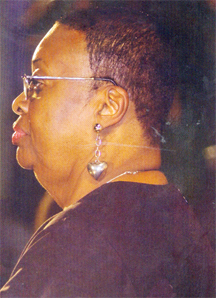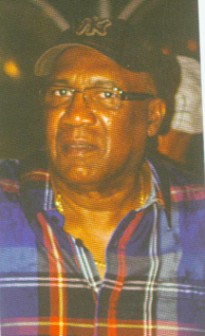By Margaret Walcott
It is the week before the Panorama Competition semi-finals. They turn off the main road into Hamilton Street and down the poorly lit path that leads to the ‘Village’ the pan yard of ‘Petrotrin Phase II Pan Groove’. In pairs, in groups, they move to their favourite spot, on the bleachers, on the far side, near to the pans. These are the hard core, the pan lovers who in the carnival season come night after night to hear the progress of their band’s arrangement.Gradually the crowd swells, here come the tourists, the local Carnival crowd, others, inquisitive, slightly out of place, but excited to be in this environment. There is the familiar background of pan players rehearsing their individual arrangement simultaneously, a cacophony of noise, an indistinguishable rumble that is perhaps distracting to the uninitiated. But this year there is a special buzz in the pan yard.The heightened interest is in the Phase II selection for the Panorama Competition. In August last year Pat Bishop died. At 71 she had passed away during a meeting of Government’s High Level Expert Panel to guide the Implementation of Arts, Cultural and Entrepreneurial Projects and Patriotism Project. Her close friends and artistic colleagues Peter Minshall and Donald ‘Jackie’ Hinkson were seated nearby when she collapsed.
At the beginning of the year, four outstanding talents had come together to produce the band’s pan tune which was to be a tribute to the departed musician; this is after seeking the blessing of her sister, Gillian Bishop, for the undertaking. Phase II Pan Groove leader Len ‘Boogsie’ Sharpe had approached Gregory GB Ballantyne to provide the lyrics for the composition. GB had collaborated with Boogsie Sharpe on many pan tunes over the years. He researched diligently and his lyrics spoke movingly and directly to Miss Bishop’s personality:

she never minced words, communication, stating honestly what she think and understandshe conducting hands in de air. She stop a practice to tell a man doh lash de pan
The lyrics were sung by the Lydian Singers, the choir that Ms Bishop had led for the past 11 years. Leston Paul, an accomplished musician, was the arranger of the instrumental version of the song. At first the song was called “The Bishop of Pan”, but then the composers approached Peter Minshall who recommended that ‘The Archbishop of Pan’ was the more appropriate title.
Pat Bishop was an extraordinary, multifaceted person. She was musician, artist, lecturer and educator who also served her country in many diverse fields. She is perhaps best known for her interest and pioneer work with the steelband and as music director and conductor of the highly regarded ‘Lydians Singers’ and ‘Lydian Steel’.
She could be described as a driven artist who worked tirelessly exhorting her fellow countrymen to take responsibility for their lives and their great cultural heritage. She used her formal education, her considerable talent, and her vision to teach, encourage and explore. She also utilised her fabled skill as a speaker; she possessed a wide, extraordinary vocabulary, a compelling turn of phrase and a keen wit. As lecturer and critic she addressed innumerable for a.
But in the end she tired, in her hope for her fellow men “that seems now to be so remote as to be impossible”. Disconsolate at the slow rate of progress and change, she talked “of retiring, of leaving this world, and soon with serenity and a quiet mood”.
This formidable woman was a national scholarship winner from Bishop Anstey High School, she obtained a BA in Art at King’s College, Durham University and a MA in History at UWI Mona Campus in Jamaica.
In time she lectured at both the St Augustine and Mona campuses of The University of the West Indies and at the Jamaica School of Art.
In the early years of her love affair with the steel band she focussed on the ‘WITCO Desperadoes Steel Band’. As its conductor and music director she took this Laventille band on eight major tours of the USA, gave major concerts at Carnegie Hall and the Brooklyn Academy of Music, and she conducted ‘Despers’ and the New York Pops Symphony in the mid 1980s.
She loved participating in the Panorama Competitions and the classical Steel Band Festivals. And in her later years, she started work with other steel bands ‘to drill and clean up’ Panorama arrangements and to do critical pan commentary for the Radio. She was particularly interested in the music composed specifically for the steel pan and she worked with several outstanding arrangers of pan music including: Jit Samaroo, Ken Philmore, Ray Holman and Boogsie Sharpe.

Len ‘Boogsie’ Sharpe had formed ‘Phase II Pan Groove’ in 1972 with six other musicians from ‘Starlift Steel Band’, they were seeking a more experimental sound for the instrument. They pioneered the decision to perform original compositions for Panorama, the National Steel Band competition, and year after year ‘Phase II’ elected to play pieces specifically composed and arranged by their talented leader.
Keith Mitchell, Phase II tenor pannist says that, “Pat saw the vibrancy of his (Boogsie’s) music and would encourage him, not to be afraid for he is an outlier, way ahead of everyone in this business. She described his music as urban contemporary”.
Boogsie Sharpe’s arrangement of ‘Archbishop of Pan’ respects and reflects the lyrics. The sound is of an orchestra, a church organ, as Mitchell says “the bass pans singing in a male voice”. Sharpe is paying homage to this strong woman, who brought her classical training to the steel pan music which in turn influenced her work, whose training was classical but whose spirit was caught-up in the new sound of the steel pans. Sharpe samples clips from Handel’s “Hallelujah” Chorus, a favourite of Bishop’s, and the “Battle Hymn of the Republic” – Glory, Glory, Allelujah, her soul goes marching on.
As for the Lydian Singers, her great love, she had taken-over the leadership of the choir, formed by Joyce Spence the music teacher of Bishop Anstey High School, in 1987 when Spence fell ill. The choir swept through the bi-annual Music Festival of Trinidad and Tobago. Bishop was always a firm supporter of the Music Festival and had herself been a successful competitor. She prepared the members of the choir for the Festival and to this day they compete with consistent success. The ‘Lydians Singers’ have developed a diverse and challenging repertoire of music under her leadership not only European but nearer home, Cuban and South American. She formed the ‘Lydian Steel’, 20 young pannists, who would address the problem of musical literacy among pannists and the blending of the pans with conventional instruments.
On the Sunday night of the Panorama semis, Phase II is in their usual spot on the track in the Queen’s Park Savannah on their way to the BIG STAGE. The atmosphere is electric, as fans, artists,musicians, the Lydians in their distinctive t-shirts, greet each other ‘Happy Carnival’. The band plays ‘Archbishop’ at a slow pace and then at the competition tempo. It is impressive. Choreographer Noble Douglas, a longtime supporter of the band and friend of Pat Bishop is sitting with Pat’s sister Gillian, she says quietly “the feeling it gives me is one of sadness, it is really a very beautiful, sad piece”.
Although the ‘Phase II Pan Groove’ topped the semis, they did not win on the final night. But for sure ‘The Archbishop of Pan’ is an important piece of music that will endure long after the Panorama competition, now in the repertoire of the ‘Lydian Singers’, one feels that it will be performed regularly, a tribute to their beloved Pat Bishop.
(Reprinted from STAN, The University of the West Indies St. Augustine Campus)





